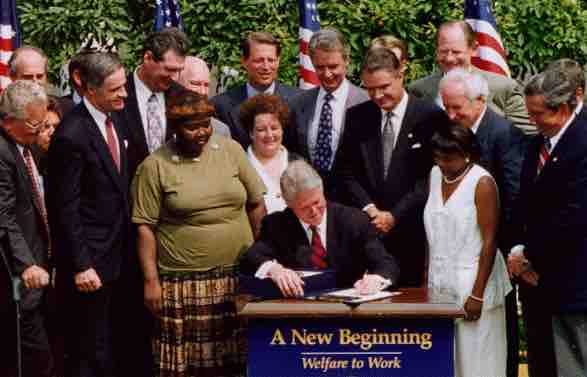Introduction
Welfare reform refers to improving how a nation helps those citizens in poverty. In the United States, the term was used to get Congress to enact the Personal Responsibility and Work Opportunity Act, which further reduced aid to the poor, to reduce government deficit spending without coining money. Social programs in the United States are welfare subsidies designed to aid the needs of the U.S. population. Proposals for federal programs began with Theodore Roosevelt's New Nationalism and expanded with Woodrow Wilson's New Freedom, Franklin D. Roosevelt's New Deal, John F. Kennedy's New Frontier, and Lyndon B. Johnson's Great Society.
Welfare Reform under President Bill Clinton
Before the Welfare Reform Act of 1996, welfare assistance was "once considered an open-ended right," but welfare reform converted it "into a finite program built to provide short-term cash assistance and steer people quickly into jobs. " Prior to reform, states were given "limitless" money by the federal government, increasing per family on welfare, under the 60-year-old Aid to Families with Dependent Children (AFDC) program. This gave states no incentive to direct welfare funds to the neediest recipients or to encourage individuals to go off welfare benefits (the state lost federal money when someone left the system).
In 1996, under the Bill Clinton administration, Congress passed the Personal Responsibility and Work Opportunity Reconciliation Act, which gave more control of the welfare system to the states though there are basic requirements the states need to meet with regards to welfare services . Still, most states offer basic assistance, such as health care, food stamps, child care assistance, unemployment, cash aid, and housing assistance. After reforms, which President Clinton said would "end welfare as we know it," amounts from the federal government were given out in a flat rate per state based on population.

Bill Clinton Signing Welfare Reform Act of 1996
A central pledge of Clinton's campaign was to reform the welfare system, adding changes such as work requirements for recipients.
Each state must meet certain criteria to ensure recipients are being encouraged to work themselves out of welfare. The new program is called Temporary Assistance for Needy Families (TANF), which was formally instituted in 1997. It encourages states to require some sort of employment search in exchange for providing funds to individuals, and imposes a five-year lifetime limit on cash assistance. The bill restricts welfare from most legal immigrants and increased financial assistance for child care. The federal government also maintains an emergency $2 billion TANF fund to assist states that may have rising unemployment.
Following these changes, millions of people left the welfare rolls (a 60% drop overall), employment rose, and the child poverty rate was reduced. A 2007 Congressional Budget Office study found that incomes in affected families rose by 35%. The reforms were "widely applauded" after "bitter protest. " The Times called the reform "one of the few undisputed triumphs of American government in the past 20 years. "
Critics of the reforms sometimes point out that the massive decrease of people on the welfare rolls during the 1990s wasn't due to a rise in actual gainful employment in this population, but rather, was due almost exclusively to their offloading into workfare, giving them a different classification than classic welfare recipient. The late 1990s were also considered an unusually strong economic time, and critics voiced their concern about what would happen in an economic downturn.